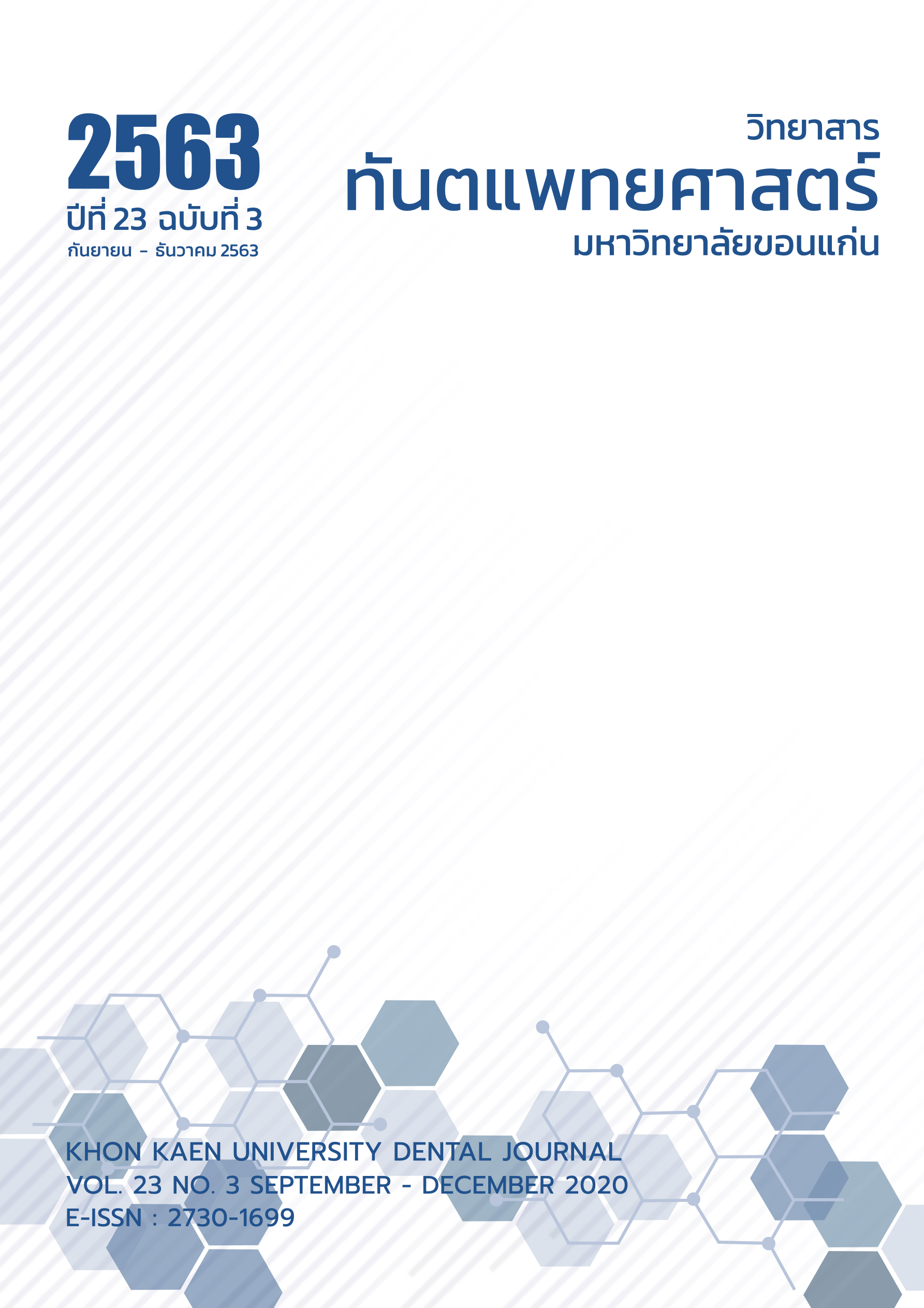การรักษาทางทันตกรรมจัดฟันในผู้ป่วยที่มีฟันกรามน้ำนมล่างซี่ที่สองยึดแข็ง: รายงานผู้ป่วย
Main Article Content
บทคัดย่อ
ฟันยึดแข็ง เป็นภาวะที่มีการเชื่อมกันของเคลือบรากฟันหรือเนื้อฟันของผิวรากฟันกับกระดูกเบ้าฟันโดยรอบ ปัจจัยภายนอกที่ทำให้เกิดฟันยึดแข็ง ได้แก่ การได้รับบาดเจ็บ การติดเชื้อ การระคายเคืองจากสารเคมีหรือความร้อน เป็นต้น ส่วนปัจจัยภายในที่อาจทำให้เกิดฟันยึดแข็ง เช่น พันธุกรรม การมีช่องว่างโดยกำเนิดของเอ็นยึดปริทันต์ เป็นต้น การรักษาทางทันตกรรมจัดฟันต้องคำนึงว่าฟันยึดแข็งไม่สามารถเคลื่อนที่ได้ด้วยแรงทางทันตกรรมจัดฟัน ในรายงานฉบับนี้ กล่าวถึงผู้ป่วยเพศหญิง อายุ 18 ปี 7 เดือน ซึ่งได้รับการรักษาทางทันตกรรมจัดฟันด้วยการถอนฟันยึดแข็งที่เป็นฟันกรามน้ำนมล่างซี่ที่สอง ฟันกรามน้อยบนซ้ายซี่ที่หนึ่ง และเคลื่อนฟันปิดช่องว่าง ผลการรักษาพบว่า เกิดการสบฟันแบบแองเกิลประเภทที่ 1 โดยเคลื่อนฟันกรามแท้ซี่แรกด้านล่างมาปิดช่องว่างได้สนิท คนไข้มีความพึงพอใจในการสบฟัน สามารถใช้ฟันบดเคี้ยวได้เป็นปกติ ใช้เวลาในการรักษาทั้งสิ้น 2 ปี 2 เดือน โดยให้ใช้เครื่องมือคงสภาพฟันไว้ตลอดเวลาเป็นระยะเวลา 2 ปี และให้ใส่เฉพาะกลางคืนต่อไปอีก 2 ปี การตัดสินใจถอนฟันยึดแข็งในผู้ป่วยรายนี้ เนื่องจากฟันยึดแข็งทั้งสองซี่มีภาวะการละลายของรากฟันมาก ทำให้ไม่สามารถผ่าตัดดึงขึ้นมาบูรณะได้ จึงได้วางแผนถอนฟันนี้แล้วปิดช่องว่าง ซึ่งการเคลื่อนฟันปิดช่องว่างในตำแหน่งฟันยึดแข็ง พบว่าทำให้เกิดการสูญเสียของกระดูกรอบขอบฟัน เนื่องมาจากขั้นตอนในการผ่าตัดเอาฟันยึดแข็งออกนั้นทำให้เกิดการสูญเสียกระดูกออกไปด้วยบางส่วน
Article Details
บทความ ข้อมูล เนื้อหา รูปภาพ ฯลฯ ทีได้รับการลงตีพิมพ์ในวิทยาสารทันตแพทยศาสตร์ มหาวิทยาลัยขอนแก่นถือเป็นลิขสิทธิ์เฉพาะของคณะทันตแพทยศาสตร์ มหาวิทยาลัยขอนแก่น หากบุคคลหรือหน่วยงานใดต้องการนำทั้งหมดหรือส่วนหนึ่งส่วนใดไปเผยแพร่ต่อหรือเพื่อกระทำการใด ๆ จะต้องได้รับอนุญาตเป็นลายลักษณ์อักษร จากคณะทันตแพทยศาสตร์ มหาวิทยาลัยขอนแก่นก่อนเท่านั้น
เอกสารอ้างอิง
Kurol J, Koch G. The effect of extraction of infraoccluded deciduous molars: A longitudinal study. Am J Orthod 1985;87(1):46-55.
Hadi A, Marius C, Avi S, Mariel W, Galit BB. Ankylosed permanent teeth: incidence, etiology and guidelines for clinical management. Med Dent Res, 2018;1(1):1-11
Messer LB, Cline JT. Ankylosed primary molars: results and treatment recommendations from an eight-year longitudinal study. Pediatr Dent 1980;2(1):37-47.
Biederman W. Etiology and treatment of tooth ankylosis. Am J Orthod 1962;48(9),670-84.
Alruwaithi M, Jumah A, Alsadoon S, Berri Z, Alsaif M. Tooth ankylosis and its orthodontic implication. IOSR J Dent Med Sci 2017;16(2):108-12.
Ekim SL, Hatibovic-Kofman S. A treatment decision-making model for infraoccluded primary molars. Int J Paediatr Dent 2001;11(5):340-6.
Kirshenblatt S, Kulkarni GV. Complications of surgical extraction of ankylosed primary teeth and distal shoe space maintainers. J Dent Child 2011;78(1):57-61.
Valencia R, Saadia M, Grinberg G. Controlled slicing in the management of congenitally missing second premolars. Am J Orthod Dentofacial Orthop 2004; 125(5):537-43.
Northway WM. The nuts and bolts of hemisection treatment: managing congenitally missing mandibular second premolars. Am J Orthod Dentofacial Orthop 2005;127(5):606-10.
Swessi DM, Stephens CD. The spontaneous effects of lower first premolar extraction on the mesio-distal angulation of adjacent teeth and the relationship of this to extraction space closure in the long term. Eur J Orthod 1993;15(6):503-11.
Winkler J, Göllner N, Göllner P, Pazera P, Gkantidis N. Apical root resorption due to mandibular first molar mesialization: A split-mouth study. Am J Orthod Dentofacial Orthop 2017;151(4):708-17.
Kim SJ, Sung EH, Kim JW, Baik HS, Lee KJ. Mandibular molar protraction as an alternative treatment for edentulous spaces: Focus on changes in root length and alveolar bone height. J Am Dent Assoc 2015; 146(11):820-9.
Klang E, Beyling F, Knösel M, Wiechmann D. Quality of occlusal outcome following space closure in cases of lower second premolar aplasia using lingual orthodontic molar mesialization without maxillary counterbalancing extraction. Head Face Med 2018;14(1):17.
Jacobs C, Jacobs-Müller C, Luley C, Erbe C, Wehrbein H. Orthodontic space closure after first molar extraction without skeletal anchorage. J Orofac Orthop 2011; 72(1):51-60.
Franchi L, Alvetro L, Giuntini V, Masucci C, Defraia E, Baccetti T. Effectiveness of comprehensive fixed appliance treatment used with the Forsus Fatigue Resistant Device in Class II patients. Angle Orthod 2011;81(4):678-83.
Cacciatore G, Ghislanzoni LT, Alvetro L, Giuntini V, Franchi L. Treatment and posttreatment effects induced by the Forsus appliance: A controlled clinical study. Angle Orthod 2014;84(6):1010-7.
Chhibber A, Upadhyay M. Anchorage reinforcement with a fixed functional appliance during protraction of the mandibular second molars into the first molar extraction sites. Am J Orthod Dentofacial Orthop 2015;148(1):165-73.
Awasthi E, Shrivastav S, Sharma N, Goyal A. Effect of forsus appliance – a case report. Int J Curr Sci Technol 2015;3(8):49-52.
Atik E, Kocadereli I. Treatment of class II division 2 malocclusion using the forsus fatigue resistance device and 5-year follow-up. Case Rep Dent 2016;3168312.
Mohamed M, Godfrey K, Manosudprasit M, Viwattanatipa N. Force-deflection characteristics of the fatigue-resistant device spring: an in vitro study. World J Orthod 2007;8(1):30-6.
Steiner DR. Timing of extraction of ankylosed teeth to maximize ridge development. J Endod 1997;23(4):242-5.
Lee KJ, Joo E, Yu HS, Park YC. Restoration of an alveolar bone defect caused by an ankylosed mandibular molar by root movement of the adjacent tooth with miniscrew implants. Am J Orthod Dentofacial Orthop 2009;136(3):440-9.


